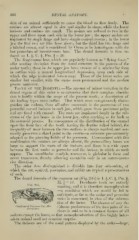Page 456 - My FlipBook
P. 456
466 DENTAL AKAT03fY.
skin of an animal sufficiently to cause the blood to flow freely. The
canines are almost equal in size and similar in shape, while the lower
incisors and canines are small. The molars are reduced to two in the
upper and three upon each side in the lower jaw ; the upper molars are
implanted by single fangs and have simple conical crowns ; in the lower
jaw the first two are like those above, but the third has two fangs and
a bilobed crown, and is considered by Owen to be homologous Avitli the
last premolars of insectivorous bats. The dental formula is thus re-
duced to I. 1, C. {, Pm. = 20.
I
The frugivorous bats, which are popularly known as " flying foxes,"
offer another deviation from the usual structure in the pattern of the
molar teeth ; those in the upper jaw have crowns of a subcircular form
in outline with a central longitudinal depression, upon each side of
which the edge is elevated into a cusp. Those of the lower series are
similar but smaller, with the cusps more pronounced and the median
groove narrower.
Teeth of the Rodentia.—The amount of minor variation in the
dental organs of this order is so extensive that their complete elucida-
tion is hardly within the scope of the present work ; a description of
the leading types must suffice. That which most conspicuously distin-
guishes the rodents from all other mammals is the possession of two
powerful curved incisors in each jaw, M'hich grow from persistent pulps
and are faced with enamel. The roots are implanted deeply in the sub-
stance of the jaw bones in the lower jaw, often reaching as far back as
the coronoid process. In consequence of the distribution of the enamel
upon the front face of the tooth, leaving the dentine naked behind, the
inequality of Avear between the two surfaces is always marked, and con-
stantly preserves a chisel point to the crown—a structure pre-eminentlv
adapted to the gnawing habits of its possessor. Concomitant with this
modification the canines are always absent, the premaxillarv bones are
large to support the roots of the incisors, and there is a wide space
between the first molar or premolar and the incisor, in which no teeth
appear. The mandibular condyle, moreover, is globular in form and
never transverse, thereby allowing excursion only in an antero-poste-
rior direction.
The order thus distinguished is divisble into four sub-orders, of
which the rat, squirrel, porcupine, and rabbit are typical representatives
of each.
The dental formula of the common rat (Fig. 245) is I. \, C. -§-, Pm. ^,
= 16. Deciduous teeth are entirely
M. -1
" " '^' wanting, and it is therefore monophyodont
—a condition which we would be led to
anticipate, as far as the molar and premolar
series is concerned, in view of the subtrac-
tion of the latter. The absence of any de-
cnuiium of conunon Kat, Mu.s ciduous prcdcccssors of the two iiairs of in-
cisors IS said to be a constant feature of all
rodents except the hares, so that monophyodontism of this highly heter-
odont animal need not occasion surprise.
The incisors are of the usual pattern displayed by the order—large.


